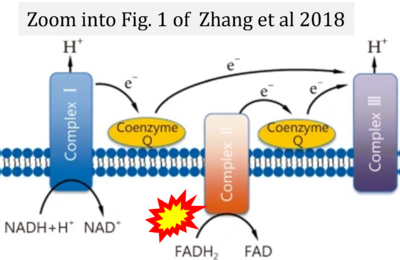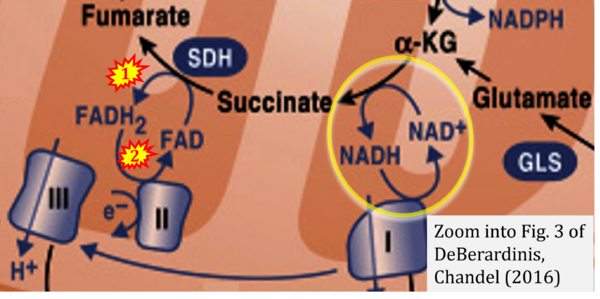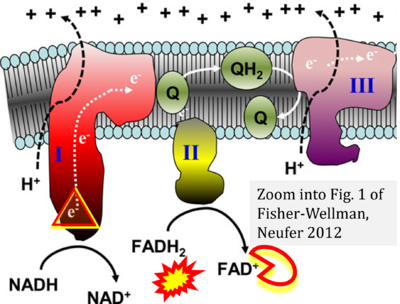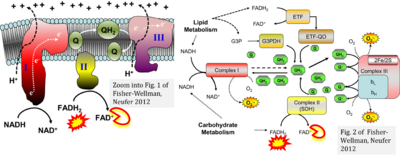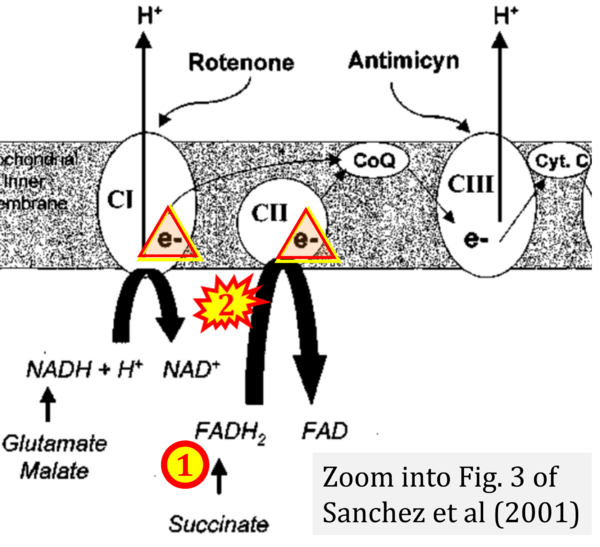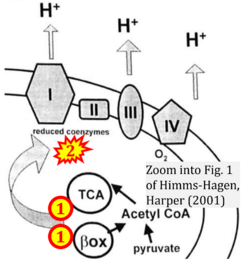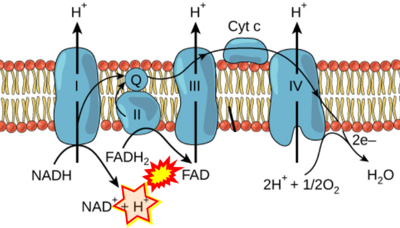Complex II ambiguities: Difference between revisions
No edit summary |
No edit summary |
||
| Line 39: | Line 39: | ||
::::# evolving errors in graphical representations: e.g. from Figure 6 (ambiguity) to Figure 1 (error) in Chandel (2021); | ::::# evolving errors in graphical representations: e.g. from Figure 6 (ambiguity) to Figure 1 (error) in Chandel (2021); | ||
::::# simple graphic errors: e.g. Yepez et al (2018), Zhang et al (2018); to | ::::# simple graphic errors: e.g. Yepez et al (2018), Zhang et al (2018); to | ||
::::# error propagation in the graphical representation solidified by the text: e.g. Arnold, Finley (2022) - 'SDH reduces FAD to <span style="background-color:#FFFF00>FADH<sub>2</sub>, which donates its electrons to complex II</span>' | ::::# error propagation in the graphical representation solidified by the text: e.g. Arnold, Finley (2022) - 'SDH reduces FAD to <span style="background-color:#FFFF00>FADH<sub>2</sub>, which donates its electrons to complex II</span>'; 'each complete turn of the TCA cycle generates <span style="background-color:#FFFF00>three NADH and one FADH<sub>2</sub> molecules, which donate their electrons to complex I and complex II, respectively</span>'; '<span style="background-color:#FFFF00>complex I and complex II oxidize NADH and FADH<sub>2</sub>, respectively,</span>'. | ||
:::: [[File:Arnold, Finley 2022 CORRECTION.png|600px|link=Arnold 2022 J Biol Chem]] | :::: [[File:Arnold, Finley 2022 CORRECTION.png|600px|link=Arnold 2022 J Biol Chem]] | ||
Revision as of 12:32, 7 March 2023
Description
The Succinate pathway is represented in the literature in some cases with a surprising confusion which warrants an analysis of Complex II ambiguities. The CII ambiguity has its roots in the narrative that reduced coenzymes (NADH and FADH2) feed electrons from the Krebs cycle into the membrane-bound electron transfer system. In corresponding ambiguous graphical representations, CII in the canonical ('forward') Krebs cycle is shown to reduce FAD to FADH2 (correct), yet CII in the membrane-bound electron transfer system is paradoxically represented as the site of oxidation of FADH2 to FAD. For clarification: "The substrate of CII is succinate, which is oxidized forming fumarate while reducing flavin adenine dinucleotide FAD to FADH2, with further electron transfer to the quinone pool. Whereas reduced NADH is a substrate of Complex I linked to dehydrogenases of the TCA cycle and mt-matrix upstream of CI, reduced FADH2 is a product of Complex II with downstream electron flow from CII to Q" (Gnaiger 2020).
Abbreviation: CII ambiguities
Reference: Gnaiger E (2020) Mitochondrial pathways and respiratory control. An introduction to OXPHOS analysis. 5th ed. Bioenerg Commun 2020.2. https://doi.org/10.26124/bec:2020-0002
Communicated by Gnaiger E (2023-03-03) last update 2023-03-07
The source and consequence of ambiguities
- Ambiguities emerge if the presentation of a concept is vague to an extent that allows for equivocal interpretations. As a consequence of ambiguous representations, even a basically clear and quite simple concept may be communicated further without appropriate reflection as an erroneous divergence from an established truth. The following quotes from Cooper (2000) provide an example.

- (1) 'Electrons from NADH enter the electron transport chain in complex I, .. A distinct protein complex (complex II), which consists of four polypeptides, receives electrons from the citric acid cycle intermediate, succinate (Figure 10.9). These electrons are transferred to FADH2, rather than to NADH, and then to coenzyme Q.'
- Comment: Here, the frequent comparison is made between FADH2 (linked to CII) and NADH (linked to CI).
- (2) 'In contrast to the transfer of electrons from NADH to coenzyme Q at complex I, the transfer of electrons from FADH2 to coenzyme Q is not associated with a significant decrease in free energy and, therefore, is not coupled to ATP synthesis.'
- Comment: Note that CI is in the path of the transfer of electrons from NADH to coenzyme Q. In contrast, the transfer of electrons from FADH2 to coenzyme Q is downstream of CII. Thus even a large Gibbs force ('decrease in free energy') in FADH2→Q would fail to drive the coupled process of proton translocation through CII, since the Gibbs force in S→FADH2 is missing. (In parentheses: None of these steps are coupled to ATP synthesis. Redox-driven proton translocation should not be confused with pmF-driven phosphorylation of ADP).
- (2) 'In contrast to the transfer of electrons from NADH to coenzyme Q at complex I, the transfer of electrons from FADH2 to coenzyme Q is not associated with a significant decrease in free energy and, therefore, is not coupled to ATP synthesis.'
- (3) 'Electrons from succinate enter the electron transport chain via FADH2 in complex II. They are then transferred to coenzyme Q and carried through the rest of the electron transport chain ..'
- Comment: The ambiguity - CII receives electrons (1) from succinate, yet it is suggested that electrons (from succinate) enter the electron transport chain (3) via FADH2 in complex II. Then two contrasting definitions are implied of the term 'electron transport chain' or better membrane-bound electron transfer system, membrane-ETS. (a) If CII is part of the membrane-ETS, then electrons enter the membrane-ETS from succinate (1) but not from FADH2. (b) If electrons enter the 'electron transport chain' via FADH2 in complex II (3), then CII would be upstream and hence not part of the membrane-ETS (to which conclusion, obviously - see Figure - nobody would agree). Dismissing concept (b) of the membrane-ETS, then remains the ambiguity, if electrons enter the membrane-ETS from FADH2 (3, wrong) or from succinate (1, correct).
FADH2 and FMNH2 in the S- and N-pathways
- Respiratory Complex CII participates both in the membrane-bound electron transfer system (membrane-ETS) and TCA cycle (matrix-ETS plus CII; Gnaiger et al 2020). Branches of electron transfer from the reduced coenzyme NADH of nicotinamide adenine dinucleotide N and succinate S converge at the Q-junction in the ETS (Figure a; modified from Gnaiger 2020).
- The reduced flavin groups FADH2 of flavin adenine dinucleotide and FMNH2 of flavin mononucleotide are at functionally comparable levels in the electron transfer to Q from CII and CI, respectively, just as succinate and NADH are the comparable reduced substrates of CII and CI, respectively (Gnaiger 2020). In CII the oxidized form FAD is reduced by succinate to the product FADH2 and the oxidized product fumarate in the TCA cycle. In CI FMN is reduced by NADH forming FMNH2 and the oxidized NAD+. FADH2 and FMNH2 are reoxidized downstream in CII and CI by electron transfer to Q in the membrane-bound ETS (Figure b).
- Gnaiger E (2020) Mitochondrial pathways and respiratory control. An introduction to OXPHOS analysis. 5th ed. https://doi.org/10.26124/bec:2020-0002
- Gnaiger E et al ― MitoEAGLE Task Group (2020) Mitochondrial physiology. https://doi.org/10.26124/bec:2020-0001.v1
FADH2 - FAD confusion in the S-pathway
- FADH2 appears in several publications as the substrate of CII in the electron transfer system linked to succinate oxidation. It is surprising that this error is widely propagated particularly in the most recent literature. For clarification, see Gnaiger (2020) page 48.
- The following examples are listed chronologically and illustrate
- ambiguities in graphical representations: FADH2 is the product and substrate of CII in the same figure, e.g. DeBerardinis, Chandel (2016);
- ambiguities with discrepancies between graphical representation and text: e.g. Figure 1 (error) and text in Fisher-Wellman, Neufer (2012) - 'Reducing equivalents (NADH, FADH2) provide electrons that flow through complex I, the ubiquinone cycle (Q/QH2), complex III, cytochrome c, complex IV, and to the final acceptor O2 to form water' (correct);
- evolving errors in graphical representations: e.g. from Figure 6 (ambiguity) to Figure 1 (error) in Chandel (2021);
- simple graphic errors: e.g. Yepez et al (2018), Zhang et al (2018); to
- error propagation in the graphical representation solidified by the text: e.g. Arnold, Finley (2022) - 'SDH reduces FAD to FADH2, which donates its electrons to complex II'; 'each complete turn of the TCA cycle generates three NADH and one FADH2 molecules, which donate their electrons to complex I and complex II, respectively'; 'complex I and complex II oxidize NADH and FADH2, respectively,'.
- The following examples are listed chronologically and illustrate
- FADH2→CII misconceptions: references and links
- Arnold PK, Finley LWS (2022) Regulation and function of the mammalian tricarboxylic acid cycle. J Biol Chem 299:102838. - »Bioblast link«
- Chen CL, Zhang L, Jin Z, Kasumov T, Chen YR (2022) Mitochondrial redox regulation and myocardial ischemia-reperfusion injury. Am J Physiol Cell Physiol 322:C12-23. - »Bioblast link«
- Turton N, Cufflin N, Dewsbury M, Fitzpatrick O, Islam R, Watler LL, McPartland C, Whitelaw S, Connor C, Morris C, Fang J, Gartland O, Holt L, Hargreaves IP (2022) The biochemical assessment of mitochondrial respiratory chain disorders. Int J Mol Sci 23:7487. - »Bioblast link«
- Ahmad M, Wolberg A, Kahwaji CI (2022) Biochemistry, electron transport chain. StatPearls Publishing StatPearls [Internet]. Treasure Island (FL) - »Bioblast link«
- Chandel NS (2021) Mitochondria. Cold Spring Harb Perspect Biol 13:a040543. - »Bioblast link«
- Martínez-Reyes I, Chandel NS (2020) Mitochondrial TCA cycle metabolites control physiology and disease. Nat Commun 11:102. - »Bioblast link«
- Morelli AM, Ravera S, Calzia D, Panfoli I (2019) An update of the chemiosmotic theory as suggested by possible proton currents inside the coupling membrane. Open Biol 9:180221. - »Bioblast link«
- Yépez VA, Kremer LS, Iuso A, Gusic M, Kopajtich R, Koňaříková E, Nadel A, Wachutka L, Prokisch H, Gagneur J (2018) OCR-Stats: Robust estimation and statistical testing of mitochondrial respiration activities using Seahorse XF Analyzer. PLOS ONE 13:e0199938. - »Bioblast link«
- Roy Chowdhury S, Banerji V (2018) Targeting mitochondrial bioenergetics as a therapeutic strategy for chronic lymphocytic leukemia. Oxid Med Cell Longev 2018:2426712. - »Bioblast link«
- Zhang H, Feng YW, Yao YM (2018) Potential therapy strategy: targeting mitochondrial dysfunction in sepsis. Mil Med Res 5:41. - »Bioblast link«
- DeBerardinis RJ, Chandel NS (2016) Fundamentals of cancer metabolism. Sci Adv 2:e1600200. - »Bioblast link«
- Fisher-Wellman KH, Neufer PD (2012) Linking mitochondrial bioenergetics to insulin resistance via redox biology. Trends Endocrinol Metab 23:142-53. - »Bioblast link«
- Himms-Hagen J, Harper ME (2001) Physiological role of UCP3 may be export of fatty acids from mitochondria when fatty acid oxidation predominates: an hypothesis. Exp Biol Med (Maywood) 226:78-84. - »Bioblast link«
- Sanchez H, Zoll J, Bigard X, Veksler V, Mettauer B, Lampert E, Lonsdorfer J, Ventura-Clapier R (2001) Effect of cyclosporin A and its vehicle on cardiac and skeletal muscle mitochondria: relationship to efficacy of the respiratory chain. Br J Pharmacol 133:781-8. - »Bioblast link«
- Cooper GM (2000) The cell: a molecular approach. 2nd edition. Sunderland (MA): Sinauer Associates Available from: https://www.ncbi.nlm.nih.gov/books/NBK9885/ - »Bioblast link«
- Oxidative phosphorylation by OpenStax Biology (CC BY 3.0) got it wrong in figures and text, and the error is propagated further, with copies in
- Conduct Science: "In Complex II, the enzyme succinate dehydrogenase in the inner mitochondrial membrane reduce FADH2 to FAD+. Simultaneously, succinate, an intermediate in the Krebs cycle, is oxidized to fumarate." - Comments: FAD does not have a postive charge. FADH2 is the reduced form, it is not reduced. And again: In CII, FAD is reduced to FADH2.
CII and fatty acid oxidation
- CII is not involved in fatty acid oxidation, which requires electron transferring flavoprotein CETF and CI. But there are confusing accounts of a rote of CII in fatty acid oxidation, which require correction:
- "Since mitochondrial Complex II also participates in the oxidation of fatty acids (6), .." (quote from [ Lemmi et al 1990]).
- Ref 6: Tzagoloff A (1982) Mitochondria. Plenum, New York.
- CII is not involved in fatty acid oxidation, which requires electron transferring flavoprotein CETF and CI. But there are confusing accounts of a rote of CII in fatty acid oxidation, which require correction:
- CHM333 LECTURES 37 & 38: 4/27 – 29/13 SPRING 2013 Professor Christine Hrycyna - Acyl-CoA dehydrogenase is listed under 'Electron transfer in Complex II'.
MitoPedia concepts:
MiP concept
MitoPedia topics:
Enzyme,
Substrate and metabolite
Labels:
MitoPedia:FAT4BRAIN











